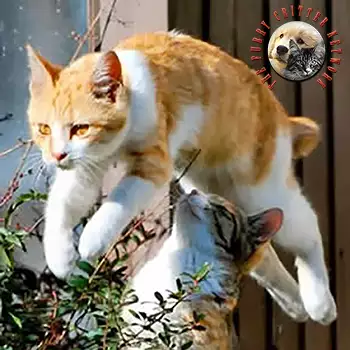Breed Standard
Head: Relatively broad and round. Moderately rounded forehead. Prominent cheeks. Muzzle slightly longer than it is wide. Medium-sized nose without clear break, not turned up. Well-developed, round whisker pads. Strong chin. Large whiskers.
Eyes: Large, round, slightly slanted. Color corresponding to that of the coat.
Neck: Short, thick, powerful.
Body: Medium-sized, solid, compact (cobby). Broad chest. Short, convex back. Croup very rounded and higher than shoulders. Heavy-boned. Muscular.
Paw: Forelegs shorter than hind legs. Heavy-boned and very muscular. Round paws. Hopping gait resembling that of a rabbit.
Tail Variety:
- Rumpy: tail absent (no caudal or coccygeal vertebrae). There must be a depression at the tail base.
- Rumpy riser: no caudal vertebrae but one to three coccygeal vertebrae covered by a tuft of hair.
- Stumpy: Tail several centimeters long, one to three caudal vertebrae, often with bone deformities ("kinked" tail).
- Taily: normal or kinked tail.
Coat: Short, dense, double coat (very thick undercoat). All colors and patterns are allowed, with or without white.
Fault: Eyes not set at a slant. Long, slender body. Flat back. Short hind legs. Fine-boned. Disqualify: weakness in hindquarters.
History
A tailless cat that hops like a rabbit This cat's name is derived from its native Isle of Man, off the coast of Ireland. These cats, described in China, Japan, Malaysia, and Russia, were once thought to be from the Far East. For example, they could have been brought by Spanish sailors after the wreck of a Spanish galleon in Philip II's invincible armada in 1588. Actually, the breed is the result of a spontaneous genetic mutation caused by a dominant autosomal gene (M) expressed in various ways: from tailless Manx cats (rumpies) to those with a normal tail (tailies). Because of the high degree of inbreeding in the feline population on the small Isle of Man, the M gene was easily passed down through many generations. The Manx was very popular in England by the late 19th century. A Manx Club was created in Great Britain in 1901. While very popular in countries including the United States and Great Britain, the Manx is quite uncommon in France. A semilonghaired Manx called the Cymric has been selectively bred in North America.
Behavior
With his excellent character, this cat adapts easily to changes in lifestyle. Manxes are sociable and accepting of other animals. Manx are prized as hunters, known to take down larger prey even when they are young. They have long been sought as mousers by farmers. A strong preference for them as ship's cats is thought to be responsible for the world-wide spread (port to port) of what originated as a very limited, insular breed.
Although all cats, including the great cats, may use both rear legs simultaneously to propel the body forward, especially when moving quickly, Manx cats are often said to move with more of a rabbit-like hop than a stride even when not running.
Health
The Manx taillessness gene is dominant and highly penetrant; kittens from two Manx parents are generally born without any tail. Being homozygous for the gene is usually lethal in utero, resulting in miscarriage. Thus, tailless cats can carry only one copy of the gene. Because of the danger of having two copies of the taillessness gene, breeders avoid breeding two entirely tailless Manx cats together. Because neither parent carries the tailless allele, a fully tailed Manx bred to another fully tailed Manx results in all fully tailed kittens.
Some partial tails are prone to a form of arthritis that causes the cat severe pain, and in rare cases Manx-bred kittens are born with kinked short tails because of incomplete growth of the tail during development. Stumpy to long tails are sometimes docked at birth as a preventative measure.
"Manx syndrome" or "Manxness" is a colloquial name given to the condition which results when the tailless gene shortens the spine too much. It can seriously damage the spinal cord and the nerves, causing a form of spina bifida, as well as problems with the bowels, bladder, and digestion. Very small bladders are indicative of the disease, and it is often difficult to diagnose. Death can occur quite suddenly, and some live for only 3–4 years; the oldest recorded was a female cat named Pharrah at 7 years when affected with the disease. In one report, it was shown to affect about 30% of Manx cats studied, but nearly all of those cases were rumpies, which exhibit the most extreme phenotype. Feline expert Roger Tabor has stated: "Only the fact that the Manx is a historic breed stops us being as critical of this dangerous gene as of other more recent selected abnormalities."
The breed is also predisposed to rump fold intertrigo, and to corneal dystrophy.
Some tailless cats such as the Manx cats may develop megacolon, which is a recurring condition causing constipation that can be life-threatening to the cat if not properly monitored. It is a condition in which, due to absence of a tail, the smooth muscle that normally contracts to push stools toward the rectum loses its ability to do so.
Following on updated genetic research, both the Australian Cat Federation and (less stringently) the GCCF impose special breeding restrictions on Manx cats (and derived stock like the Cymric), for animal welfare reasons.






